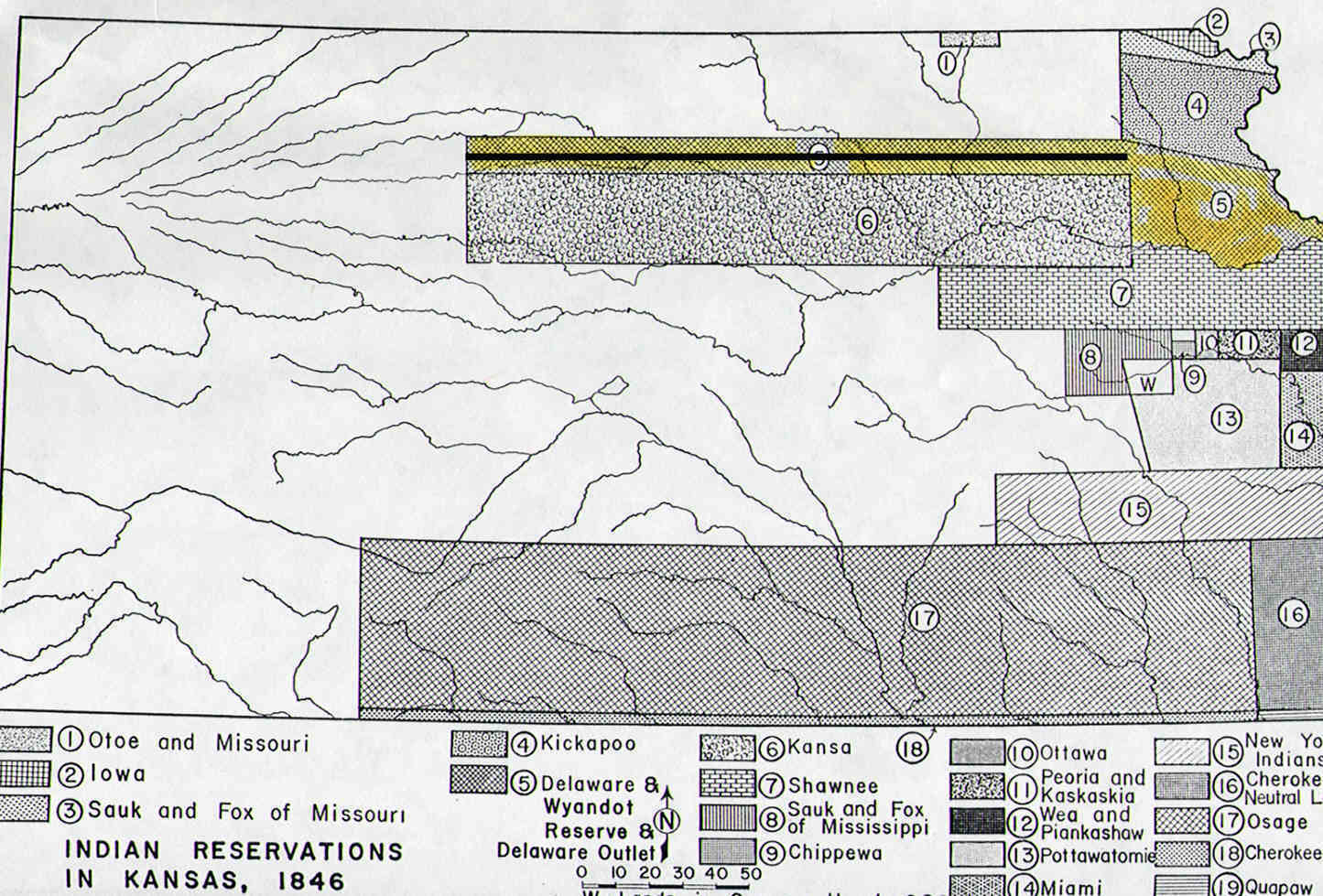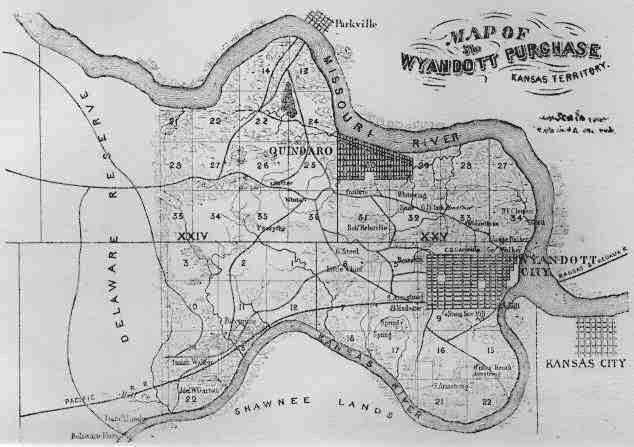From the
Encyclopedia of North American Indians we learn that
he was one of a set of triplets born at Old Piqua, on the Mad
Rive4 in western Ohio.
His mother was Methoataske (Turtle
Laying Its Eggs), a Creek woman. His father,
Puckeshinewa, a Shawnee war chief, was killed at the
Battle of Point Pleasant prior to the triplets' birth. The
triplets were the youngest siblings in a large family (they
had at least six older brothers and sisters), and one of the
triplets died in infancy. The other triplet, Kumskaukau,
lived at least until 1807.
In 1779 Methoataske left Ohio. The two
remaining triplets and Tecumseh, a brother born in
1768, were left in the care of Tecumapease, an older,
married sister. Their upbringing also was supervised by
Chiksika, a brother in his late teens. Both Tecumapease
and Chiksika favored Tecumseh, an athletic youth who excelled
at the contests and games popular among Shawnee boys. In
contrast, the boy who would become the Prophet was an awkward,
corpulent youth who accidentally gouged out his own right eye
while fumbling with an arrow. Because he often boasted and
complained, he was called Lalawethika (the Noisemaker),
a name he disliked. He married in his teens, but was unskilled
as a hunter and became an alcoholic. He did not participate in
the Indian victories over Josiah Harmar (1790) or
Arthur St. Clair (1791), but he did join a war party of
Shawnees led by Tecumseh who fought at the Battle of Fallen
Timbers. Following the Treaty of Greenville (1795) he lived
with a band of Shawnees led by Tecumseh who resided at several
locations in western Ohio and eastern Indiana. In 1798 they
moved to the White River near Anderson, Indiana, where
Lalawethika, still an alcoholic, unsuccessfully attempted to
assume a role as a healer and shaman.
In the decade following the Treaty of
Greenville socioeconomic conditions among the Shawnees and
neighboring tribes deteriorated. Game and fur-bearing animals
declined, while frontiersmen encroached upon Indian land,
poaching the few remaining animals and establishing new
settlements. White juries protected Americans accused of
crimes against tribes people while systematically convicting
Indians. Meanwhile, many Indian people contracted new diseases
for which they had no immunity. Under considerable stress,
tribal communities were plagued with apathy and dysfunction,
and alcoholism increased. Considerably alarmed, many Shawnees
believed that their troubles were caused by witches spreading
chaos in the Shawnee world.
During April 1805, in the midst of this
crisis, Lalawethika underwent a religious experience in which
he appeared to fall into a trance so deep that his family at
first believed him to be dead. After a few hours he recovered
and informed his neighbors that he had died, had been taken to
a location overlooking heaven and hell, and had been shown how
the Shawnees could improve their situation. He stated that
although Indians had been fashioned by the Creator, Americans
were the children of the the Great Serpent, the source of evil
in the world. Aided by witches (Indians who accepted American
cultural values), the Americans had spread chaos and disorder.
In consequence, he championed a new religious revitalization,
urging the Shawnees and other Indians to minimize their
contact with the Americans. He admonished tribespeople to
relinquish American food and clothing, most manufactured
goods, and alcohol. Firearms could be used for defense, but
game should be hunted with bows and arrows. If Indians
followed such doctrines, their dead relatives would return to
life and game would reappear in the forests; if they refused,
they would be condemned to a fiery hell reminiscent of
Christian doctrines. He also announced that thenceforward he
should be known as Tenskwatawa (the Open Door), a name
befitting his new role as a prophet.
Tenskwatawa's teachings found many adherents
among the Shawnees and neighboring tribes, particularly after he
successfully predicted an eclipse of the sun in June 1806. By
1807 so many Indians had traveled to his village near
Greenville, in western Ohio, that they exhausted food supplies
in the region. White officials became alarmed at this influx,
and in 1808 the Prophet led his followers to Prophetstown, a new
village near the juncture of the Tippecanoe and Wabash Rivers,
near modern Lafayette, Indiana.
In 1809, after the Treaty of Fort Wayne,
Tecumseh attempted to transform the religious movement into a
centralized political alliance designed to retain the remaining
Indian lands in the West. From Prophetstown Tecumseh traveled
throughout the Midwest. In November 1811, while Tecumseh was
recruiting allies in the South, William Henry Harrison,
the governor of Indiana Territory, led an expedition against
Prophetstown. Forced to protect his village, Tenskwatawa
promised his followers that they would be immune from American
firearms and instructed them to attack Harrison's camp. In the
resulting conflict, the Battle of the Tippecanoe, the Indian
attack was repulsed. Although both sides suffered losses, the
Prophet's influence was broken. When Tecumseh returned from the
South in January 1812 he assumed sole command of the Indian
alliance
Never a warrior, the Prophet took little
part in the War of 1812. In December 1812 he fled to Canada,
then accompanied Tecumseh back to northern Indiana. In the
following spring they led a large party of western warriors to
the Detroit region. The Prophet accompanied the British and
Indian forces that unsuccessfully besieged Fort Meigs during
May 1813, but he took no part in the fighting. On October 5,
1813, he was present at the Battle of the Thames, but he fled
with the British when the battle started. Tecumseh was killed
in the battle.
Following the War of 1812, the Prophet
remained in Canada for ten years, unsuccessfully attempting to
regain a position of leadership. In 1825, at the invitation of
Lewis Cass, the governor of Michigan Territory, he returned to
the United States and used his limited influence to promote
Indian removal. One year later he accompanied a party of
Shawnees from Ohio who were traveling via St. Louis to Kansas.
The Prophet settled at the site of modern-day Kansas City,
Kansas, where he posed for the artist George Catlin in the
autumn of 1832. He died there four years later, in November
1836.
The Encyclopedia of North American
Indians was published by the
Houghton-Mifflin Company of Boston and New
York, 215 Park Avenue South, New York, New
York, 10003. Encyclopedia of North American
Indians / Frederick E. Hoxie, editor. p. cm.
Includes index. 1. Indians of North
America—Encyclopedias. I. Hoxie, Frederick
E. E76.2.E53 1996 970.004'97'003—dc20
96-21411 CIP Book design by Anne Palms
Chalmers (Potawatomi ancestry). ISBN
0-395-66921-9. We highly recommend this work
to our readers.
|
|
|
|
|
|


